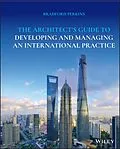Start or grow your architectural firm with this masterful guide to international practice, featuring country-specific information for over 185 countries
The Architect's Guide to Developing and Managing an International Practice is the definitive resource for architects considering or already engaged in projects outside the United States. Offering expert guidance on every essential aspect of international expansion and management success, this comprehensive volume covers recruiting, licensing, strategic planning, current trends, emerging technologies, and more. Author L. Bradford Perkins clarifies and expands upon the major issues that architects face when they begin to explore how to enter a new international market for their services.
This real-world guide is designed for young architects and architectural students thinking about working overseas, for firm leaders pursuing international projects for the first time, and for established global firms seeking to expand or refine their ongoing international practices. It includes advice drawn from dozens of conversations with leading architects who have worked in dozens of countries around the world. A must-read for architecture and design professionals wanting to successfully win and carry out work abroad, this book will help you:
- Plan an entry into international practice
- Pick the best initial or next international market for your services
- Sell and contract for your services
- Manage the financial aspects of international practice
- Invoice and collect what is owed to you
- Enhance your domestic practice with international work
- Understand the telecommunication, software, and technology platforms required
- Identify and avoid the common problems of international practice
- Understand how experienced global firms effectively deal with risks and issues
Written by the co-founder of Perkins Eastman Architects, an international architectural firm with more than 1000 employees and work experience in over 60 countries, The Architect's Guide to Developing and Managing an International Practice is an indispensable reference and guide for any architect planning to seek work outside the United States.
Bradford Perkins, FAIA, is Co-founder and Chairman of Perkins Eastman Architects, a New York City-based architecture, planning, design, and consulting firm. In his 50-year career, he has directed several hundred projects across a dozen building types in more than 30 countries. Perkins is the author of eight textbooks and more than 100 published articles and book chapters on architectural and planning, is a faculty member the Cornell University College of Architecture, Art, and Planning, and is the recipient of dozens of awards for planning and design excellence.
Autorentext
Bradford Perkins, FAIA, is Co-founder and Chairman of Perkins Eastman Architects, a New York City-based architecture, planning, design, and consulting firm. In his 50-year career, he has directed several hundred projects across a dozen building types in more than 30 countries. Perkins is the author of eight textbooks and more than 100 published articles and book chapters on architectural and planning, is a faculty member the Cornell University College of Architecture, Art, and Planning, and is the recipient of dozens of awards for planning and design excellence.
Inhalt
Acknowledgements xv
List of Figures xvii
Chapter 1 Introduction and Historical Overview 1
Introduction 1
Why Firms Pursue or Choose to Avoid International Practice 7
How Firms Start 8
Reasons to Have an International Practice 9
Reasons to Be Cautious 13
References 15
Chapter 2 Getting Started 17
Researching the Major Issues 17
Developing a Plan 23
First Steps 29
What Country is the Right Place to Start? 29
How to Start 32
Questions to Answer During an Initial Exploration 32
Getting the First Projects 33
Contract Issues 34
Case Studies 34
Perkins Eastman 34
Ennead Architects 41
MASS Design Group 44
ZGF Architects 46
KPF 48
Oppenheim Architecture+Design 48
Reference 51
Chapter 3 The Major International Markets 53
Americas 55
Canada 55
Mexico and Central America 64
Mexico 66
Central America 71
South America 73
Brazil 80
Colombia 84
Ecuador 86
The Caribbean Islands 88
Bahamas 92
Bermuda 92
Dominican Republic 94
Jamaica 94
Trinidad and Tobago 95
Asia 96
China 97
Reasons to be there 105
Reasons to be cautious 107
What firms are currently operating in China? 107
Special Administrative RegionsHong Kong and Macau 124
East Asia 130
Southeast Asia 147
South Asia 172
Australia, New Zealand, and the Pacific Islands 184
Who is There 184
The Potential Clients 186
Domestic Firms 186
Licensure 186
The Middle East and North Africa 187
The Gulf States and Saudi Arabia 189
The Middle East 211
Egypt and North Africa 227
Sub-Saharan Africa 234
Angola 234
Benin (formerly Dahomey) 234
Botswana 234
Burkina Faso 237
Burundi 238
Cameroon 238
Central African Republic 238
Chad 238
Comoros 239
Democratic Republic of the Congo 239
Republic of the Congo 239
Djibouti 239
Equatorial Guinea 239
Eritrea 240
Ethiopia 241
Gambia 241
Gabon 241
Ghana 241
Guinea 243
Guinea-Bissau 243
Ivory Coast (Côte d'Ivoire) 243
Kenya 243
Lesotho 244
Liberia 244
Madagascar 244
Malawi 245
Mali 245
Mauritania 246
Mauritius 246
Mozambique 246
Namibia 246
Niger 246
Nigeria 247
Reunion 249
Rwanda 249
São Tomé and Príncipe 250
Senegal 250
Seychelles 250
Sierra Leone 251
South Africa 251
Somalia 251
Sudan 252
Swaziland (Now Eswatini) 252
Tanzania 252
Togo 252
Uganda 253
Western Sahara 253
Zambia 253
Zimbabwe 254
Russia and the States of the Former Soviet Union Chart and Map 254
Russia 256
The Former Soviet Republics 259
Central and Eastern Europe 263
Albania 265
Bosnia and Herzegovina 266
Bulgaria 267
Croatia 267
Czech Republic (Czechia) 267
Hungary 268
North Macedonia 269
Moldova 269
Poland 269
Romania 270
Serbia 270
Slovakia 271
Slovenia 271
